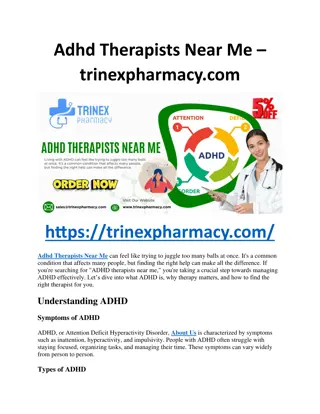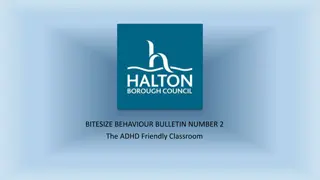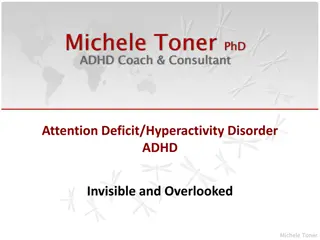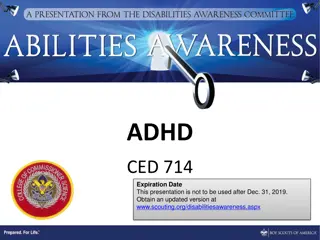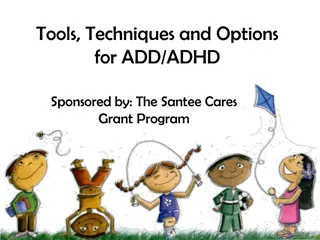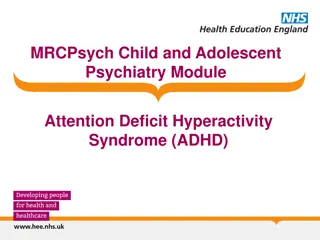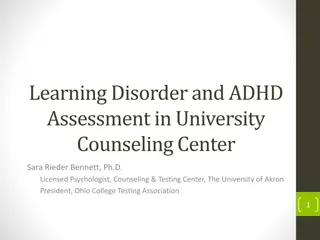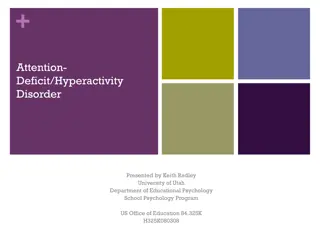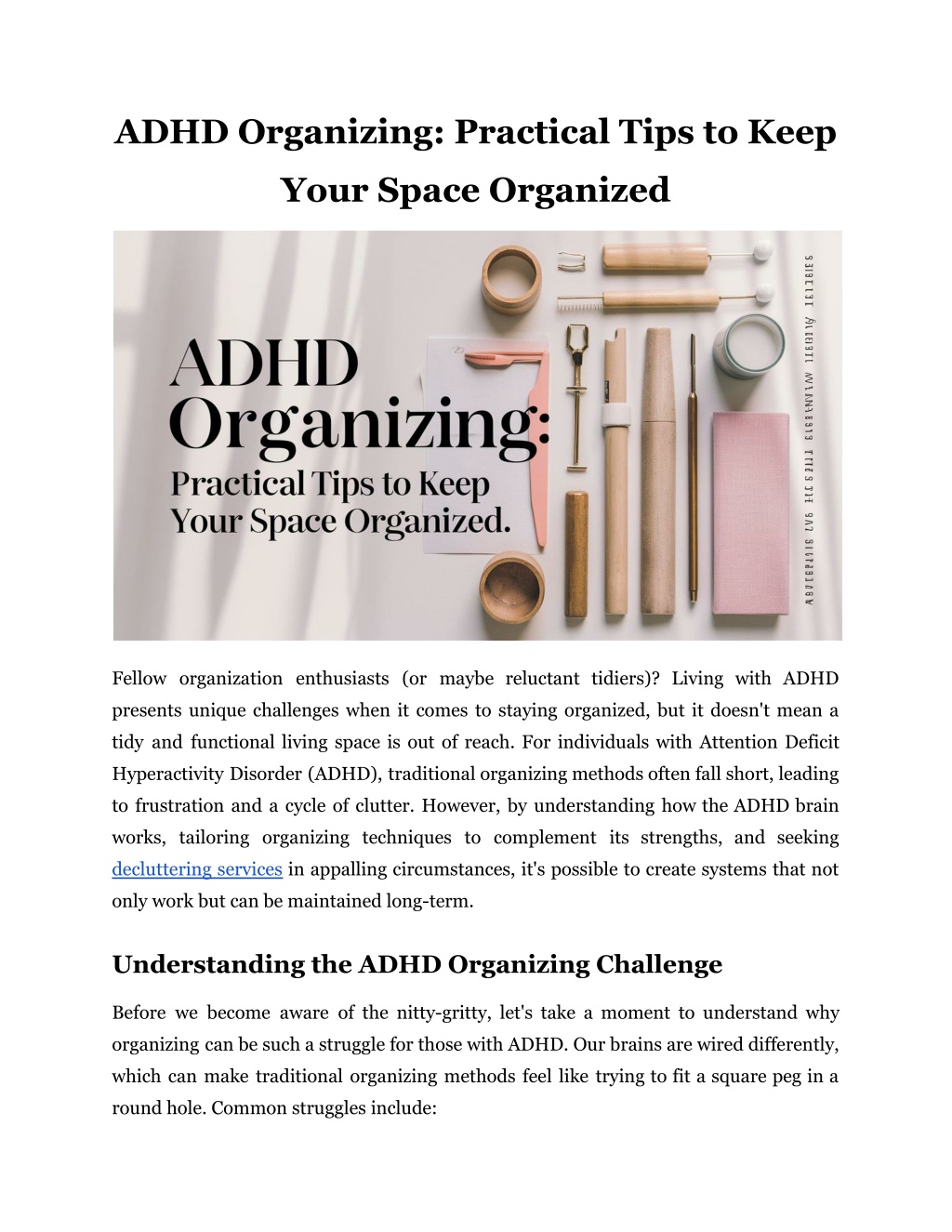
ADHD Organizing_ Practical Tips to Keep Your Space Organized
However, by understanding how the ADHD brainnworks, tailoring organizing techniques to complement its strengths, and seekingndecluttering services in appalling circumstances, it's possible to create systems that notnonly work but can be maintained
Download Presentation

Please find below an Image/Link to download the presentation.
The content on the website is provided AS IS for your information and personal use only. It may not be sold, licensed, or shared on other websites without obtaining consent from the author. Download presentation by click this link. If you encounter any issues during the download, it is possible that the publisher has removed the file from their server.
E N D
Presentation Transcript
ADHD Organizing: Practical Tips to Keep Your Space Organized Fellow organization enthusiasts (or maybe reluctant tidiers)? Living with ADHD presents unique challenges when it comes to staying organized, but it doesn't mean a tidy and functional living space is out of reach. For individuals with Attention Deficit Hyperactivity Disorder (ADHD), traditional organizing methods often fall short, leading to frustration and a cycle of clutter. However, by understanding how the ADHD brain works, tailoring organizing techniques to complement its strengths, and seeking decluttering services in appalling circumstances, it's possible to create systems that not only work but can be maintained long-term. Understanding the ADHD Organizing Challenge Before we become aware of the nitty-gritty, let's take a moment to understand why organizing can be such a struggle for those with ADHD. Our brains are wired differently, which can make traditional organizing methods feel like trying to fit a square peg in a round hole. Common struggles include:
Difficulty prioritizing tasks Tendency to get easily distracted Problems with time management Challenges in creating and sticking to routines These traits can make conventional organizing advice feel overwhelming or ineffective. 15 Best Tips to Keep Your Space Organized 1. The Golden Rule: Start Small, Dream Big I can't stress this enough: don't try to Marie Kondo your entire life in one weekend. That's a surefire way to end up overwhelmed and discouraged. Instead, let's break it down: Choose one small area to start with: Maybe it's your desk, or that one drawer that's become a black hole for random stuff. Set a timer for 15-20 minutes: You'd be surprised how much you can accomplish in a short, focused burst. Celebrate your progress, no matter how small! Remember, Rome wasn't built in a day, and your perfectly organized space won't be either. But every small step is progress! Read More Articles: A Complete Guide to Flower Delivery Services in NYC 2. Make It Visual: Your ADHD Brain Will Thank You Our ADHD brains often struggle with object permanence. Out of sight really can mean out of mind. So, let's make your organizing system as visual as possible: Use clear storage containers: Being able to see what's inside can be a game-changer. Color-code everything: Assign colors to different categories. For example, blue for work stuff, green for hobbies, and red for important documents. Label, label, label: Get a label maker and go wild! Label shelves, boxes, and folders - if they hold stuff, they get a label.
Set up a command center: Use a whiteboard or bulletin board to keep important notes, schedules, and reminders in plain sight. 3. Create Zones: Your Personal City Planning Project Think of your living space as a mini-city, with different neighborhoods for different activities. This zoning approach can help keep things organized and make it easier to find what you need. Here are some zone ideas: Work Zone: For your laptop, important documents, and work supplies. Relaxation Zone: A cozy corner for reading or unwinding. Creativity Zone: Where you keep art supplies, musical instruments, or other hobby items. Maintenance Zone: A spot for cleaning supplies, tools, and household essentials. 4. Time Management: The Other Half of the Organizing Battle Organizing isn't just about managing stuff - it's about managing time too. Here are some expanded strategies to help you stay on track: Choose a task Set a timer for 25 minutes Work on the task until the timer rings Take a short 5-minute break Every four "Pomodoros", take a longer 15-30 minute break This technique helps prevent hyperfocus and keeps you moving between tasks. Plus, it makes boring tasks more bearable - you can do anything for just 25 minutes, right? 5. Time Blocking: Give Your Day Some Structure Time blocking involves dividing your day into chunks dedicated to specific tasks or types of activities. Here's an expanded example: Time Activity 8:00 - 8:30 Morning routine 8:30 - 9:00 Commute/Prepare for work
9:00 - 10:30 Deep work on a priority project 10:30 - 11:00 Check and respond to emails 11:00 - 12:30 Meetings/Calls 12:30 - 1:30 Lunch and a short walk 1:30 - 3:00 Continue project work 3:00 - 3:30 Quick tidy-up of workspace 3:30 - 5:00 Wrap up daily tasks, and plan for tomorrow 5:00 - 6:00 Commute/Transition to Home Time 6:00 - 7:00 Dinner prep and eating 7:00 - 8:00 Household chores/Organizing 8:00 - 10:00 Free time/Hobbies 10:00 - 11:00 Wind down routine Adjust the times and activities to fit your life. The key is to have a visual representation of how you intend to spend your time. 6. Reminders: Your Digital Memory Assistant Your smartphone can be a powerful tool in your organizing arsenal. Here are some ways to maximize its potential: Set recurring reminders for regular tasks like taking out the trash or paying bills. Use location-based reminders. For example, set a reminder to pick up dry cleaning that pops up when you leave work. Try apps like Todoist or Any.do that can sync across devices and send push notifications.
7. Decluttering: The Ongoing Battle Clutter is the arch-nemesis of organization. Here's how to keep it at bay: The "One In, One Out" Rule: Your New Shopping Mantra Before you bring something new into your space, decide what's going to leave to make room for it. This helps prevent accumulation and makes you more mindful of your purchases. If you still struggle to keep your surroundings clean, you can get help from a specialist like the skillful team at Before & After Organizing by Jan. They can suggest and implement numerous decluttering techniques, aiming to enhance your living atmosphere. 8. Daily Reset Routine: Your 15-minute Miracle At the end of each day, set a 15-minute timer and do a quick reset of your space. Put things back where they belong, clear off surfaces, and prepare for the next day. This daily habit can prevent small messes from becoming big problems. 9. The Two-Minute Rule: Your Secret Weapon Against Procrastination If a task will take less than two minutes to complete, do it immediately. This includes things like: Hanging up your coat instead of tossing it on a chair Putting dishes in the dishwasher instead of the sink Filing a paper instead of adding it to a pile These small actions can prevent a lot of clutter from accumulating. Read More Articles: The Magic of Night Berry: Sweet Dreams Lullaby Berry Gummies Explained 10. Keep Frequently Used Items Within Reach Store things you use often in easily accessible places. This might mean: Keeping your favorite mug right by the coffee maker Storing your most-used cooking utensils in a container on the counter
Having a charging station for your devices right where you usually sit in the evening 11. Minimize Visual Clutter: Out of Sight, Peace of Mind Too much visual stimulation can be overwhelming for the ADHD brain. Use these strategies to reduce visual clutter: Use baskets or boxes with lids to store items on open shelves Choose furniture with built-in storage, like ottomans with hidden compartments Use drawer dividers to keep small items organized and out of sight 12. Create a "Drop Zone": Your Landing Pad Designate a spot near your entrance for everyday items. This could include: A key hook or bowl A small tray for wallets and phones A basket for mail and papers that need attention Having a dedicated spot for these items can save you countless hours of searching and reduce stress. 13. Break It Down: Embrace the Power of Small Wins Instead of "clean the entire bedroom," try breaking it down into smaller tasks: Make the bed Clear off nightstand Put away clean laundry Organize one dresser drawer 14. Reward Yourself: Celebrate Your Organizing Victories Set up a reward system for yourself. It doesn't have to be big - maybe it's watching an episode of your favorite show after you organize your closet, or treating yourself to a fancy coffee after tackling your paperwork. 15. Get Support: Two Heads (or Hands) Are Better Than One Consider working with a "body double" - someone who sits with you while you organize. They don't even have to help, just their presence can provide accountability and moral
support. You could also join online ADHD organizing groups for tips and encouragement. When to Call in the Pros: No Shame in Getting Help? If you're still struggling despite your best efforts, it might be time to consider professional help. Two main types of professionals can assist you. ADHD Coaches: These specialists can help you develop strategies tailored to your specific challenges and strengths. Professional Organizers: Many organizers now specialize in working with ADHD clients. They can help you set up systems that work for your brain and teach you how to maintain them. (One notable name here is Organizing by Jan ). Decluttering services can also be a lifesaver if you're feeling overwhelmed by the sheer amount of stuff you need to sort through. These professionals can help you make decisions about what to keep, what to donate, and what to discard. The Golden Rule: Progress, Not Perfection As we wrap up, I want to emphasize this point: the goal isn't a picture-perfect Instagram-worthy space (unless that's your thing, in which case, go for it!). The goal is to create a space that supports you and makes your life easier. And most importantly, be kind to yourself. Organizing with ADHD is a skill, and like any skill, it takes practice. Celebrate your progress, learn from your setbacks, and keep moving forward. Before & After Organizing by Jan specializes in creating custom organizing solutions for individuals with ADHD and those who struggle with traditional organizing methods. From implementing visual organizing systems to creating personalized time management strategies, we offer a comprehensive suite of decluttering services that go beyond mere decluttering.
Site Article: ADHD Organizing: Practical Tips to Keep Your Space Organized






